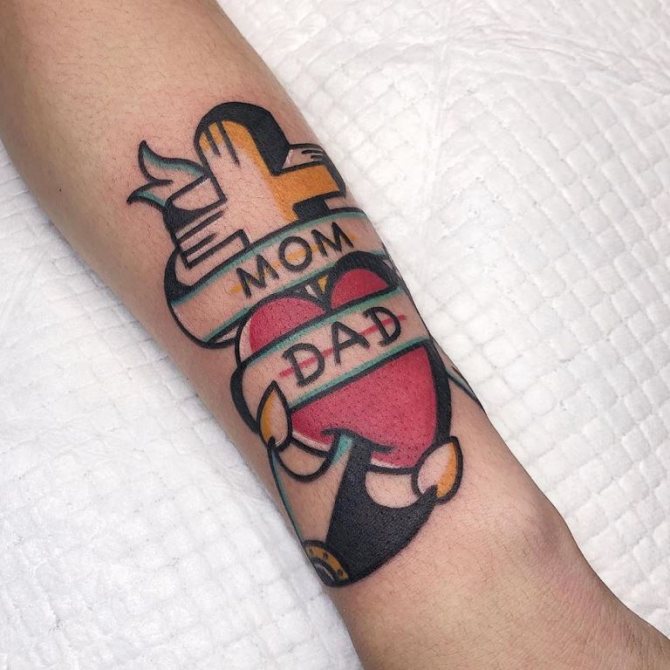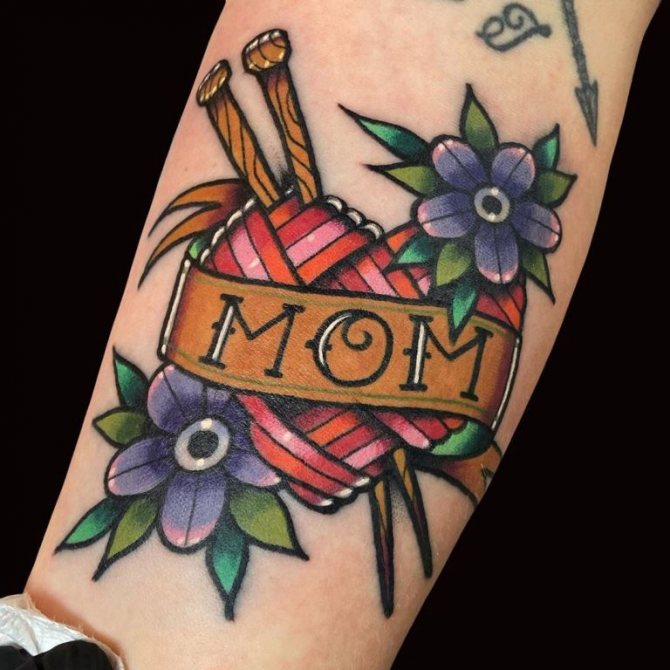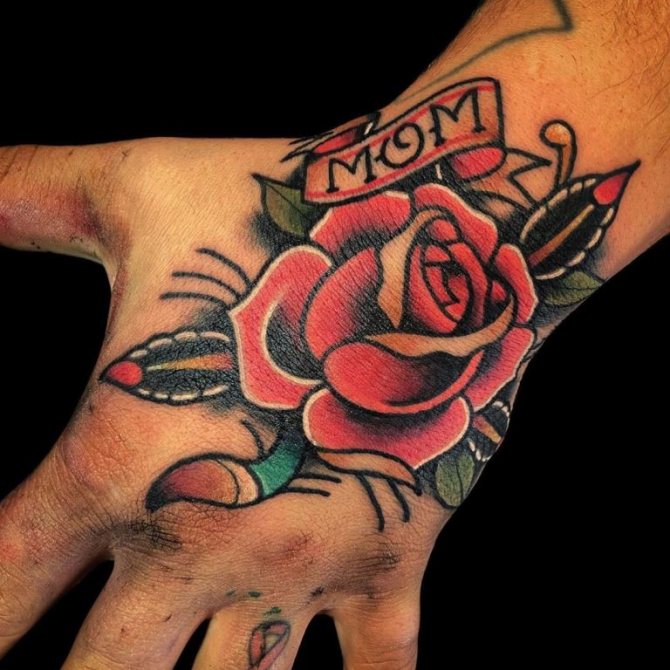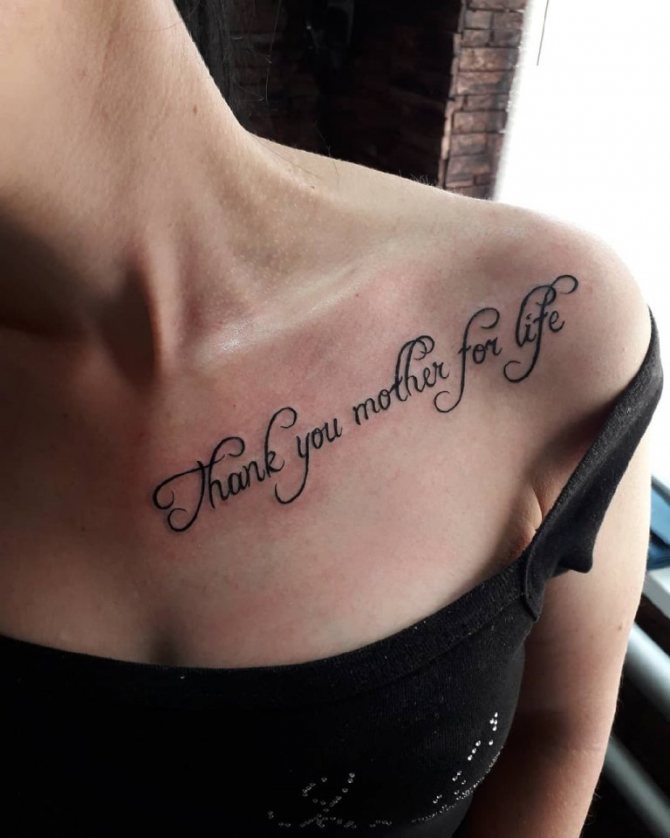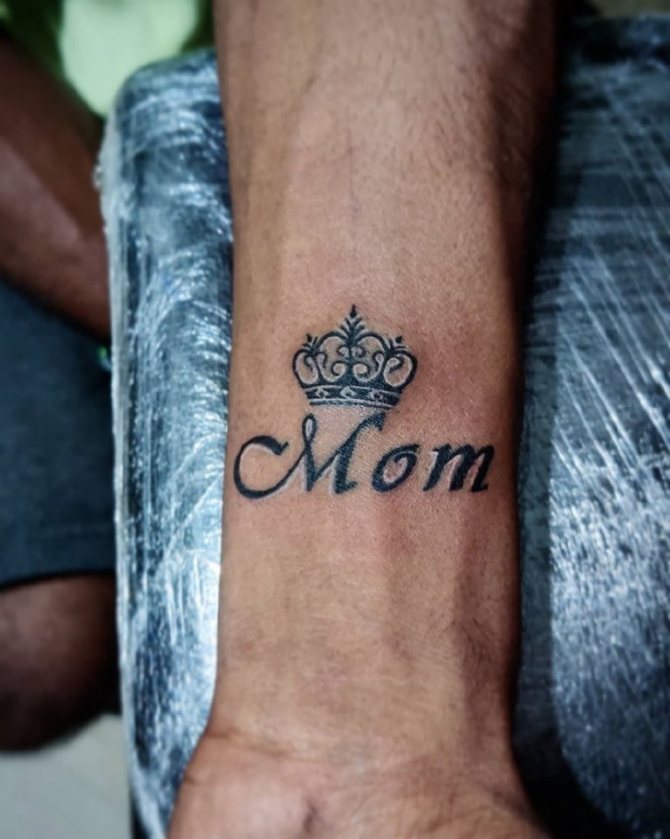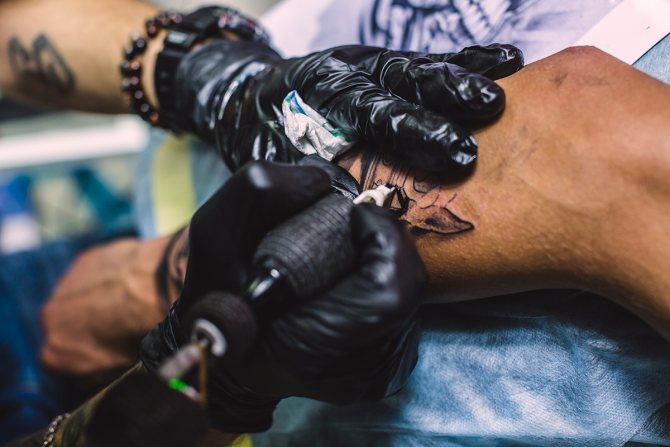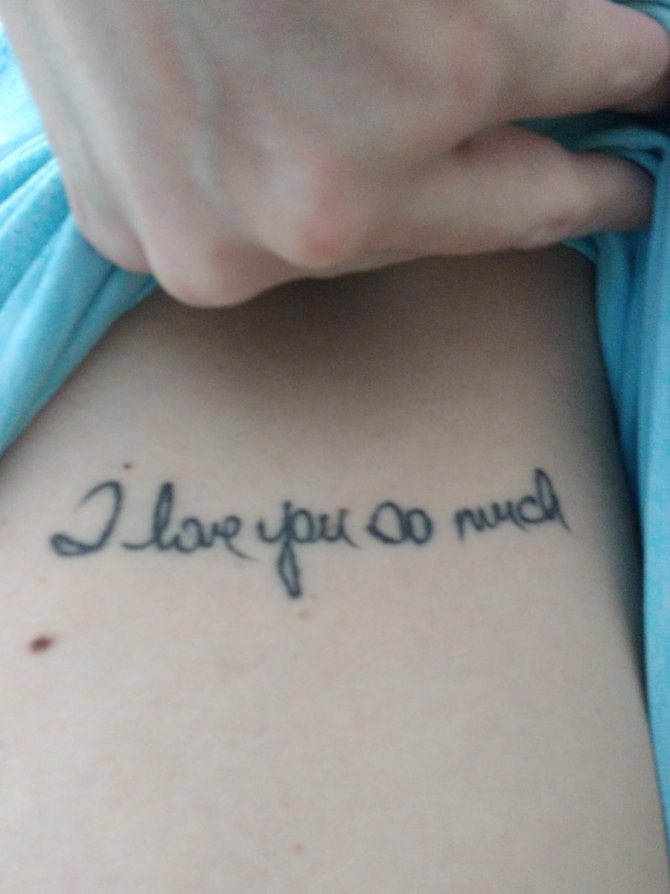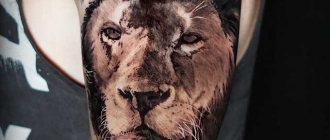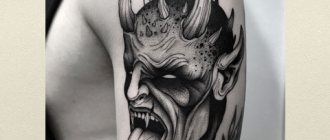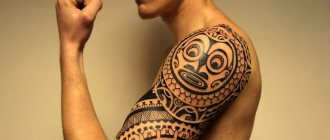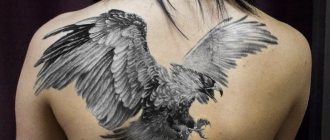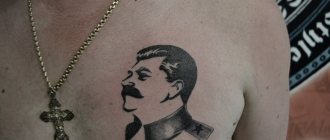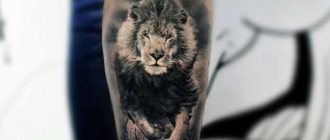
We all have people in our lives that we want to remember and feel close to us always. For some - it's parents, for others - a childhood friend, others can say that about their significant other. A keepsake tattoo is a great way to keep a piece of someone dear to you.
A keepsake tattoo will be your symbol of unbreakable bond, love and reverence. What subject to choose, where to place the future drawing and other issues we will consider in this article.
Tattoo for memory in the style of "Traditional"
"Traditional" is a popular stylistic option in which a memory tattoo can be made. Drawings in this style have been done for decades to immortalize the thoughts of someone close to them. Even in the '60s, some sailor had a heart inscribed with the name of his beloved on his shoulder.
What options for tattoos can be done in the traditional style?
- Already mentioned heart with a ribbon, on which is written the name of the person. Most often the composition is complemented by roses around it. More often than not, this is how tattoos are made in honor of the mother.
- The name, surrounded by clouds or wings, can indicate that that tattoo is made in memory of a deceased person.
- The person's name may also be written on a scroll. It is not uncommon to supplement this with dates (birth or death).
Facts about tattooing:
- In ancient Japan, a person with a tattoo was persona non grata: he was banished from family and society, condemning him to complete isolation. The tattoos on the bodies of criminals were usually prominent and could even tell in which prison they were serving their sentences.
- In the Japanese province of Chukuzen during the Edo period (1603-1867), as punishment for the first offense, bandits were given a horizontal line across the forehead, an arc-shaped one for the second, and another one for the third. The result was a composition that made up the hieroglyph INU - "dog". To this day, a person who has a drawing on his body is forbidden to work in a public office, to bathe in public places.
- In ancient China, one of the five classic punishments was also a tattoo on the face. Slaves and prisoners of war were also tagged, making it difficult for them to escape. To this day, there is an elaborate system of prison tattoos in places of incarceration around the world that imprints a person's lifelong history of their crimes and punishments.
- The ancient Greeks and Romans also used tattoos for similar purposes, marking slaves. The practice was revived by the Spanish conquistadors in Mexico and Nicaragua.
- Mayan women tattooed their faces, which was considered a sign of low origin.
- The word "tattoo" is a borrowing from Polynesian languages. This is how the wild tribes living on the islands of Polynesia called tattoos on the body. This method of "decoration" was first scientifically described during his voyage around the world by English explorer James Cook in 1773. He used the word from the language of the natives, as there was no such concept in European languages.
- From his voyage, James Cook brought not only his notes, but also the "Great Omai" - a Polynesian covered entirely in tattoos. The appearance of such a marvel caused a sensation in European cities. No self-respecting performance, fair, or traveling circus was without the participation of the "noble savage.
- It was from traveling circuses that the fashion for tattooing went to the masses. Since natives were not always available, circus performers painted themselves with tattoos. For example, in the early 19th century, a certain lady Viola flaunted portraits of six American presidents, Charlie Chaplin and many other celebrities, enthralling the crowds and making money from it. In parallel, in the same nineteenth century, laborers of the artels began to put pigment marks on their bodies to indicate their fraternity, and sailors to commemorate their voyages.
- During the First World War in Britain, the "D" tattoo was used to mark deserters.
- Tattooing was practiced in the SS divisions. The main theme in the tattoos of soldiers of the Third Reich was Nazi symbolism. After the surrender of Hitler's Germany, the Allies easily captured the SS with an external inspection.
- Islam prohibits absolutely all tattoos, even those with religious content.
- In ancient Israel tattooing as part of one of the pagan rituals was expressly forbidden by one of the commandments: "For the sake of the dead, do not make cuts on your body and do not tattoo writing on yourself. I am the LORD (your God)" (Leviticus 19:28, also Deuteronomy 14:1). This Bible injunction is still followed by Jews and Christians today.
A tattoo in memory of the deceased
A drawing that is done in memory should be personal, pointing to a specific person, reflecting something that connected you.
But there are a number of "standard" symbols that are done most often in memory of a departed person.
- A broken or pierced heart will immediately indicate that you had to lose someone close in your life. Alternatively, the heart can have a piece chipped off and placed next to the name written on it.
- A feather, from which birds seem to fly out, is another symbolic image. There can be a name and dates of birth and death underneath the design to indicate - this tattoo is not just for beauty.
- A similar idea is that of a dandelion, from which the seeds are flying up. As with the previous option, the dates and the person's name will look appropriate here.
Tattoo as a ritual
The Church refers to tattoos somewhat negatively. Tattoos have been known since ancient times. There is an opinion that the first tattoo appeared by accident. Some person had a wound, dirt got there and stayed there. Such "tattoos" have now almost all miners who work underground. Coal dust gets into the cuts, and the marks remain.
In ancient times, tattoos had different meanings. First, informational: seeing a certain tattoo, a person understood what kind, tribe his interlocutor was from, what status he was in. The second meaning was mystical: a person tried to use it as an amulet, thinking that this particular tattoo would protect him from some kind of disease. The third meaning was ritual, magical: these were tattoos made by priests, chiefs.
In the Old Testament we find a ban on the use of such tattoos. The book of Leviticus says: "For the sake of the dead, do not make cuts on your body and do not tattoo writing on yourself. I am the LORD (your God)" (Leviticus 19:28). The book of Deuteronomy also forbids them: "You are sons of the LORD your God; you shall not make cuts [on your body] [or hair over your eyes for the dead" (Deuteronomy 14:1). That is, the pagan tribes had such rituals to commemorate the dead. The Pentateuch of Moses explicitly forbids this so that the Jewish people would not follow barbaric traditions that led to ritual murder and other abominations.
A Double Tattoo to Remember
You don't have to limit yourself to just one area of the body! The tattoo can be divided into two parts - on the right hand and left hand. When you close your hands together, the picture will come together.
What can be depicted in this way from memory tattoos?
- It can be a quote, a prayer that you divide into two parts and put on your forearms.
- Unfortunately, quite often people lose two loved ones at once - their parents. In memory of them, you can scribble their names and dates of death on the wrists of the right and left hand.
- An interesting idea: on one hand depict a baby with his hand raised up, and on the other - a balloon flying away with the word "daddy" or "mommy."
- Perhaps you didn't want to get a memory tattoo by yourself, but together with someone (such as siblings in honor of deceased parents). Then you can choose a panoramic composition and share it with everyone. Only it's worth considering that each tattoo individually looks good, too.
Related Questions
If you have recently had a tattoo, it is contraindicated for you to donate blood. After the procedure itself (tattooing) at least one year must pass. As for acupuncture, it is the same. And the presence of a tattoo itself is not an absolute contraindication to donation.
October 1 is World Tattoo Day. Archpriest George Tsyganov, head of eparchial department for cooperation with penitentiary service, rector of St. Righteous John of Kronstadt Church in Kirovskoye, told about whether it is possible to participate in the sacraments of the Church with tattoos and whether there are Orthodox tattoos.


Special Symbols to Remember
Deciding to immortalize the memory of a person on your body, you can think about his features. For example, profession, favorite occupation, etc.
What memory tattoo can you get from this category?
- A racing fan can be immortalized on the body by simply tattooing the silhouette of a horse.
- An athlete can be marked with some kind of trophy.
- With a motorcycle fan everything is obvious - it's either the "iron horse" itself, or a burning wheel, or a license plate.
- Even for the pastry chef, you can pick up an appropriate symbol: for example, a hat, a rolling pin, or just a tattoo with a beautiful cake.
Why is the Church against tattoos?
Nowadays, tattoos with the faces of Christ, the Virgin Mary are stuffed. People who have nothing to do with the criminal world think that this will be a kind of their talisman. The Church has a negative attitude towards this. God created man to be perfect. Trying to add something to that perfection, we take upon ourselves the mission of God - trying to show that we know better than Him and are more capable. Mostly those who have tattoos have a desire to show off, to distinguish themselves.
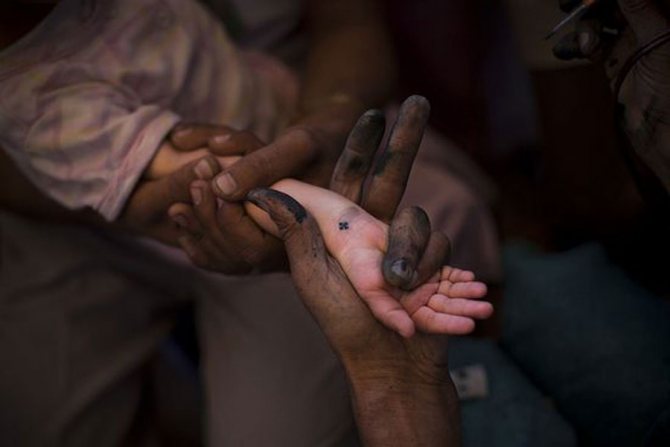

A Coptic girl with a cross tattoo on her wrist. Photo: B. Armange / Associated Press
Options for placing a memory tattoo
As a rule, memory tattoos are placed on prominent parts of the body. In this way, people show their reverence for the person and remind others of him. For such a purpose, it is worth choosing the front part of the torso, arms, legs, chest.
- A complex composition with many details will take up a lot of space. For the drawing to come out with quality, allocate space on the back, chest, thigh or shoulder.
- Small tattoos can be placed on the wrists, fingers, ankle.
- If you want to hide the tattoo from prying eyes, place it on the back of the neck, behind the ear.
A keepsake tattoo is a good way to leave a piece of a dear person with you. But you should not exaggerate your suffering: if you have parted with your other half, the longing may seem incredible. But time will pass, and you will feel better. But the tattoo won't go anywhere - the ink stays under the skin forever. So approach this action in a balanced way.
Answers
Tanya19 5 (3743) 3 35 75 8 years old
Better pray for the salvation of his soul or at least put a candle in the church. Why would you do that? I wouldn't do it.
Crazy Animal 6 (6816) 2 8 36 8 years
God is against decorating the body, for the body is the temple of the Lord
rDk (28) 6 (7905) 3 8 19 8 years
who cares what you do!!! if it makes you happier do it and don't think about what others will think.
RioDeSoila 6 (5155) 3 13 8 years
Are you out of your mind? Do you want to go to him? You'll hurt him and you'll hurt yourself. You have to let go of the ones that are gone, and you're anchoring him to yourself. And you need to live, and live well. And be happy. And you have to let him go. In general, we must be very careful in choosing a tattoo, it's a stamp on the body for life. Even if you later remove it.
Kamedi_Mila (28) 7 (31144) 5 83 227 8 years
better write him a letter, and send it to a distant box
lojcin 7 (92187) 34 176 789 8 years
The Word of God says: ,,You shall not make yourself an idol, images. God does not approve of such things (-this is my conclusion).
Butch 6 (6661) 2 6 14 8 years
It's all been said a long time ago:
- Deuteronomy 14:1 You are sons of the Lord your God; you shall not make cuts in your body, nor cut out any hair above your eyes for the dead;
- Leviticus 19:28 For the sake of the deceased, you shall not make cuts on your body, and you shall not tattoo writing on yourselves. I am the Lord.
If I were you, I'd rather worry about how your future spouse and children (if future life is planned at all, of course), rather than God, would feel about it.
Energy2012 2 (486) 1 5 8 years
I think you can think of something else, such as a medallion with a common photo, and he will always be with you. or something else, many things, you need to think.
Are tattoos in the form of a cross or an icon allowed?
Christians in the East have a tradition of tattooing. In Africa and the Middle East, Christians tattoo small crosses on their arms. They live in constant danger. The Muslim world is very aggressive toward Christians. In making this sign of the cross, Christians show the firmness of their faith and their readiness to walk with Christ even in death. In the event of death, this sign will help ensure that they are buried in a Christian manner.
This differs from our penitentiary traditions of embossing crosses all over the back - there is a small cross, which is hidden somewhere under the clothes, like our body cross. The people around us do not see it unless we intentionally display it. At the same time, we know that this symbol of our faith is always with us.
In the twelfth century, the Arab conquerors who invaded Egypt began to forcibly convert Christians to their religion. One form of resistance to this was that Coptic Christians began to tattoo a cross on the inside of their right wrist. Because Islam explicitly forbids tattoos and because a tattooed cross cannot be removed, forcible conversion to Islam became impossible for Copts.
Centuries later, tensions between Christians and Muslims in the East have not disappeared. Christians still place a cross on their hands, as an expression of their preparedness to be martyred for Christ and their refusal to convert to Islam.
We will be held accountable for all of our actions. I met a lot of people, especially in the army, who had such tattoos. Then, when they came to faith, they were ashamed of the tattoo and didn't want the people around them to see it. It was a very painful process, not many people went through with it. A person who is just coming to God and wants to get a tattoo, I would advise him to think about how much he needs it. Any bracelet, medallion we can remove. One day I like it, and the next day I don't. A tattoo can't be taken off. It is very painful to burn it off.
Can a person with a tattoo be a priest?
Yes, he can. We even have an example of a tattooed priest, Ivan Okhlobystin. But a tattoo can make life difficult in the future. Our people have a very strong conviction that if a person has tattoos, it means he belongs to the criminal world. For a priest, if he has a tattoo on some open place, it can be very difficult to communicate with people. Some will be indifferent, but many will be alarmed.
A priest is usually looked upon as some kind of ideal person in whom everything must be perfect. People often do not want to take into account that he is a human being just like the rest of us, so a priest with tattoos can be in for a lot of trouble. Although it will not alienate him from God in any way.
The dangers of tattooing are something that tattoo parlors tend to gloss over or downplay.
The red paint used for tattoos contains mercury sulfide, other shades contain titanium, chromium, lead and cadmium. Blue paint is considered the most dangerous. It includes cobalt and aluminum. Paraphenylenediamine and arsenic, the components of black ink, are no less dangerous. The last component can easily provoke cancer, and all others poison the body and lead to muscle tissue damage. The pigments used in tattoo parlors are not controlled by health authorities.
Death at the end of a needle
Thousands of people have contracted HIV, hepatitis B and C with a tattoo needle. Many viruses are not killed by boiling or other types of sterilization.
The cancer that might not have been there
It's not just the arsenic in the paint that causes it. A lot of people try to hide birthmarks and other skin defects with the help of tattoos. Meanwhile, to do so is strictly prohibited. In fact, not only a mole, but any tattoo under the influence of ultraviolet sunlight can provoke skin cancer.
According to a study conducted in Europe, one third of clients of salons and private masters faced with the negative effects of tattoos.
It is impossible to remove a tattoo without leaving a trace. Even with laser removal scars remain. At removal by other means the size of scars will be more the size of the vvodimaya tattoo by virtue of destruction of a skin covering. In fact, to remove a tattoo is to lose a piece of your own skin.

